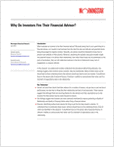You may have read or heard me talk about the research that led to my P4 Practice Management Principles (see Investment Advisor’s November 2011 cover story “Let It Grow”). What led me to conduct that research—and discover the P4 Principles—was the realization that half my clients were hiring good employees and turning them into great employees, while the other half were hiring great employees and making them mediocre at best.
Ironically, we were able to quickly and easily compare the historical performance of each employee because we don’t do performance reviews with the employees in our client firms any more. That’s because we found that once we established effective communications based on solid working relationships with our employees, we didn’t have anything to talk about in the annual reviews. Instead, we simply have our owner-advisors conduct a “360 Performance Assessment” on every employee every year, which tells us everything we need to know about how each employee is doing, in a data format that can be sliced and diced in myriad ways to spot trends and gauge overall firm performance.
It’s the best way we’ve found to communicate an advisory firm owners’ expectations to their employees. We highly recommend it to help firms—and employees— quickly get a handle on what they’re doing well, and what they need to work on.
Our Performance Assessments (which you can download for free on our website) rate employees from 1 to 5 in each of 9 key areas that we’ve determined contribute to building successful advisory practices. As you’ll see, they focus more on how employees do their jobs rather than on what they do.
The Nine Areas of Assessment
- Business Focus: understanding the firm’s vision and mission; setting personal objectives, goals and milestones; demonstrating prudence with company resources.
- Customer Focus: Adapting work process to meet clients’ changing demands; looking for ways to exceed client expectations; ensuring that work is defect-free.
- Results Oriented: Consistently delivering outstanding results;
a) anticipating obstacles before they become a crisis
b) taking corrective action for unsatisfactory performance
- Leadership: Accepting responsibility rather than blaming others:
a) managing stressful situations;
b) motivating team members to work together. - Communications: Providing candid feedback without offending;
a)asking for others’ points of view;
b)addressing conflicts without attacking others. - Initiative: Challenging current business practices; adopting new approaches; willing to experiment with others’ ideas.
- Planning and Organization: Correctly prioritizing assignments; fairly distributing workload; doesn’t waste time.
- Decision Making: Taking the proper amount of authority; evaluating options; making timely decisions.
- Interpersonal Skills: Earning of trust to represent owner’s interests; earning respect of team members; building friendly relationships.
With these 360 Performance Assessments, which are shared with each employee, firm owners can communicate their expectations of what makes a great employee, motivate their employees to become great and gauge their progress toward making an optimum contribution to the success of the business.
Lastly, speaking of success, as we enter the Thanksgiving holiday I would like to share with you a poem my financial advisor, Brian Fenn of Carolina Capital Consulting, shared with me. It’s about being thankful for all the success we have and all the love we share.
I hope you enjoy your holiday, and my best to you, your employees, your businesses and mostly, those you love.
What Is Real Success?
By Tim Conner
Everyone wants success, and yet they often don’t know when they have it.
For most, it is the maddening chase toward a better way of life or more of something.
More fame, power, recognition, money, or material stuff.








 November 20, 2012 at 04:39 AM
November 20, 2012 at 04:39 AM










